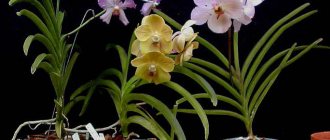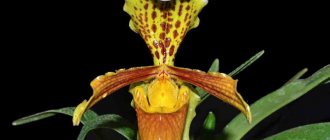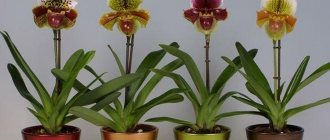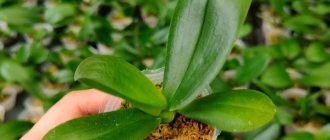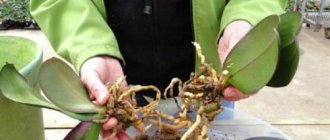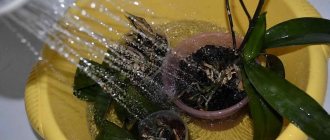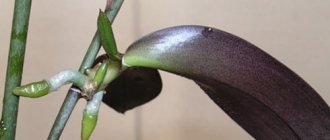Origin of the orchid
In the wild, Paphiopedilum prefers the territory of Southeast Asia, since it thrives best in subtropical, monsoon and tropical climates. If we talk about the literal translation, then paphiopedilum is translated as “slipper from Paphos”, and Paphos is considered the birthplace of Venus. This is where the popular name came from - lady's slipper.
This orchid even has its own legend, according to which Venus really wanted to be alone with her lover and, while rushing to meet Adonis, lost her golden slipper right in the middle of the forest. A hunter passing in these places discovered the loss and wanted to pick it up from the ground, but the shoe instantly turned into a beautiful and delicate flower. This orchid is the true embodiment of tenderness, grace and sophistication.
Main varieties with photos
Main varieties and types:
Harris
An artificially bred hybrid, which is mainly used for gardening purposes, visibly expands and decorates any area. Because of this, it was nicknamed the garden orchid. It has an interesting pattern that resembles a grid. The leaves are mostly light green, the flowers themselves can be dark purple and yellow with green veins .
Paphiopedilum Milenkii
It was delivered to our latitudes from Thailand, small in size and brightly colored. The flowers are usually small, with small spots, but the petals are large and wide. You can find out about other varieties of Paphiopedilum here.
Horny
A variety that appeared in Europe back in 1885, and the birthplace of orchids is considered to be Vietnam. Flowering mainly occurs in the spring. This variety differs from others in its rather large flowers. The main color is blue-green.
Fire
The variety, which came to Europe from distant India, is distinguished by its small size and vertically expanded flowers. The flowering period occurs in spring and summer.
Sukhakula
Thailand is considered to be the birthplace of the variety. It prefers a tropical climate and is distinguished by its rather large flowers, which can reach 14 centimeters in diameter.
Rothschild
The orchid was named after Baron Ferdinand de Rothschild , an orchid lover and patron of horticulture in Borneo.
Description of the plant
The roots of a healthy plant should be brown and covered with fine fibers. When a period of active development begins, their tips become noticeably white. The rosette can be formed from leaves of different shapes, which can be belt-shaped or broad-linear. They have a beautiful, rich green hue, and you can even see patterns on some.
One rosette can bloom only once. The peduncle can have a length from 4 to 60 cm. Only one shoe is formed on it. Most species of this plant have very bright flowers and come in various shades of red, yellow and green. The lip especially stands out: it is the one that attracts insects, who like not only its brightness and beauty, but also its sweet honey aroma.
3.Varieties
3.1.Paphiopedilum concolor - Paphiopedilum concolor
Very delicate, compact orchids with thick, fleshy, belt-shaped leaves of a dark green color, 10 - 16 cm long. The leaf blades have small light green specks on the surface. Peduncles are short, strong, abundantly pubescent, up to 10 cm high. Each peduncle can bear 1 - 3 delicate buds. The flowers reach a diameter of 5 - 8 cm, have yellowish, pink or cream petals, with small brown or burgundy freckles on the surface. The lip is rounded, reminiscent of a woman's slipper.
↑ Up,
3.2.Paphiopedilum delenatii
Delicate, blooming orchids with oblong-lanceolate, thick leaves, painted in a dark green hue. The leaf blades are entire and may have small light green specks on the surface. The peduncles are leafless, abundantly pubescent, vertical, reaching a height of 30 - 40 cm. Each plant is capable of producing several peduncles, on the tops of which there are 1 - 3 large, fragrant flowers. The flower petals are painted white or slightly pinkish, the lip can be lilac, purple or burgundy. During the flowering period, flower stalks need support.
↑ Up,
3.3. Paphiopedilum micranthum or small-flowered - Paphiopedilum micranthum
An orchid with thick, juicy, fleshy leaves arranged oppositely. The leaf blades are entire, dark green, with light green specks on the surface, up to 15 cm long. Each plant produces a tall, leafless, pubescent, slightly curved peduncle at the top with a single, showy flower. The flowers reach 10 cm in diameter, the petals can be painted in white, pinkish, lilac, lemon yellow, orange or burgundy shades. On the surface of the petals there is a mesh of dark, thin stripes. The flowers have very large lips.
↑ Up,
3.4.Paphiopedilum bellatulum or pretty - Paphiopedilum bellatulum
Blooming compact orchid with 4 - 5 thick, succulent dark green leaves. Leaf blades up to 15 cm long and about 5 cm wide are covered with small light specks. Peduncles are short, strong, pubescent. Flowers with white or pinkish petals speckled with burgundy and reach a diameter of 6 cm.
↑ Up,
3.5.Paphiopedilum Maudiae
Low orchids with plain or spotted green oblong-oval leaves. The leaf blades are thick and entire. The peduncles are erect, leafless, reach a height of 30 cm, each bears a single flower at the top, which remains attractive for 2 months. The flowers are painted in a greenish-white or pinkish-burgundy hue, reaching a diameter of 10-12 cm. The lip is often monochromatic, while the petals have longitudinal thin stripes of a dark color.
↑ Up,
3.6. Paphiopedilum niveum or snowy - Paphiopedilum niveum
Compact plants up to 25 cm high with oblong oval dark green leaves with light speckles. The leaf blades reach 15 cm in length and 3.5 cm in width. Peduncles are thin, erect or slightly curved at the apex, pubescent. Each peduncle has 1 flower with wide white or pinkish petals. The diameter of the flowers can be 6 - 8 cm. The petals often have tiny burgundy specks - freckles on the surface.
↑ Up,
3.7.Rothschild's Paphiopedilum - Paphiopedilum rothschildianum
Tall orchids, reaching 75 cm in height. The leaves are green, glossy, long, belt-shaped. The leaf blades are entire, up to 40–60 cm long and about 5 cm wide, slightly bent along the central vein. Peduncles are thin, vertical, pubescent, and may require support. Each peduncle is capable of bearing 2 - 4 large, showy flowers. The flower petals are narrow, yellowish, soft pink or white, with thin brown or burgundy stripes. The lip is often monochromatic - burgundy or brown.
↑ Up,
Planting a lady's slipper
Lady's slippers are planted in opaque pots, which should be made of plastic or ceramics. You should choose a pot of such a size that it exactly matches the size of the plant’s root system. You can also use a transparent container. This is usually done in order to constantly monitor the condition of the roots and lower layers of the substrate.
In general, young plants are usually replanted every year. You can do this a little less often (once every two or three years), but for this there must be at least one of the following reasons:
- ten or more rosettes were formed in the pot;
- the flower has a young growing shoot and there is a desire to propagate the plant by division;
- flowering has just finished;
- By observing the condition of the lower layers of the substrate, the gardener sees that salinization of the soil is occurring, which affects the condition of the plant.
Some gardeners who have orchids recommend updating the soil a little every six months.
Required soil
Making a substrate for planting paphiopedilum orchids is quite simple. You need to mix three parts of pine bark and one part of peat soil for seedlings. But this is only the basis of the substrate. As additional components, you can also use charcoal, sphagnum moss, which retains moisture well, coarse river sand and expanded clay. As for pH indicators, it will be better if it is at a neutral level. Even slightly acidic soil is acceptable.
Care and maintenance at home
It has already been said that lady’s slipper is a rather unpretentious plant. Feels great both in the garden and indoors.
Since the root is located high to the surface of the earth and is wide, we recommend taking a wider container. We fill a quarter of it with drainage. Then - the base: a mixture of pine bark and peat 3:1. Add charcoal, sand and chalk. Sometimes it is replaced with dolomite flour. Place sphagnum moss on the surface. It will help maintain the desired humidity for the flower.
The scorching sun can be detrimental to the shoe. And yet there should be 12-14 hours of bright lighting per day. In autumn and winter, when there is very little light, additional artificial lighting is necessary. Heat-loving species will be grateful to the following indicators: +22C – +32C during the day. +15C. – not lower at night. I can withstand +16C – +22C for other plant varieties. At night +8C – +10C, lower limit +6C. If the thermometer drops below +5C, the orchid may die.
Watering and fertilizing
Like all orchids, Lady's slipper does not store nutrients. The plant receives nutrition through watering. Therefore, make sure that the soil is not too dry. To avoid harming the leaves, you should not spray them. But you can and should wipe with a damp cotton pad.
You can water in two ways: 1) from a watering can until water appears on the pan; 2) immersing the pot completely in water. We are waiting for the earth to be saturated with water. Let it drain. When watering, try not to get into the base of the rosette so as not to cause rotting. It will be better for a beautiful flower if you water it in the morning. In summer - 1-2 times a week, in winter - 2 times a month with settled or boiled water.
ATTENTION. Please do not keep the plant near heating devices! In the spring, once every two to three weeks, be sure to add fertilizer and water your green pet with it. Alternate mineral fertilizers and organic matter. In the fall, once a month, we recommend rinsing the soil with clean water to remove salt accumulation.
During the dormant period, fertilizing is not necessary. From mid-November there begins a period of rest. The leaves darken and become spotted.
Reproduction and transplantation
Dividing the bush is the easiest way to propagate the Paphiopedilum orchid. Young animals are transplanted once a year. Adults - once every three years. On the eve of transplantation, the plant is watered abundantly. The pot is taken with a slightly larger diameter. diseased or damaged roots are removed. The cut areas are sprinkled with ash.
After transplantation, the young plant is placed in a shaded place and watered until young shoots appear. Then they return to their usual place.
Where should it be placed in the house?
It is best to place a pot with this orchid on an east or west window, but you can also choose a north-west or north-east window sill. Development is also progressing well on the northern side, but it is better to resort to this placement option only when absolutely necessary. Also, the room where the orchid will stand should be frequently ventilated, but not create drafts. In summer, it is better to take flowers out into the garden or onto the loggia.
Lady's slipper grows well in a room with diffused light and can easily withstand slight shading, but it is better not to allow this. However, the plant should not be exposed to direct sunlight. As for the temperature regime, information from different experts is quite controversial. Much here depends on the chosen variety.
If we talk about general indicators, in summer the optimal air temperature is from 18 to 25 degrees; in winter, the temperature can drop by 10 degrees, but not for long. When summer is especially hot, the flower can tolerate an increase in air temperature of up to 33 degrees. The flower does not go into hibernation.
Air and moisture
When the lady's slipper enters a period of active growing season, it needs abundant and regular watering. However, we should not forget that it is necessary to periodically dry the substrate, which should be short-term. This is necessary for the simple reason that this plant extremely does not like stagnation of water in the root system.
Because of this, the orchid very quickly develops fungal diseases, which can then be very difficult to cure. Therefore, the gardener’s task in this case is to organize balanced watering. You also need to constantly monitor the microclimate in the room: at the slightest change, the watering tactics need to be changed.
Orchids need to be sprayed, and this is not news to anyone, but if even small droplets fall on the rosette, they must be immediately removed with a dry cloth. The rosette is the most vulnerable place of the plant, where rot can form almost immediately.
The air humidity in the room should be approximately 80%, but slight reductions are allowed. There are several ways to increase the humidity level in a room:
- you can install an indoor fountain;
- some prefer to purchase special devices;
- Sphagnum moss is placed on top of the substrate and carefully sprinkled with water every morning.
- the most accessible method for everyone: containers with flowers are placed on a pallet, which is strewn with wet pebbles or expanded clay.
Reasons for lack of flowering
Indoor orchids, like any other flowering plants, require special, close to natural growing conditions. Everyone knows that under natural conditions these flowers are common in the tropics, which means they need special conditions. Often the main reasons why the flowering period does not occur are associated with the following disorders:
- if lighting parameters are violated;
- if temperature fluctuations occur;
- if humidity indicators are violated;
- if watering is performed incorrectly;
- if the wrong fertilizer is used;
- if the substrate is out of date or of poor quality.
In order for the plant to bloom frequently, you need to comply with the basic requirements for growing, as well as regular feeding and timely watering. If flowering does not begin, and the leaves of the plant wither, then the growing conditions should be reconsidered, the violation of which often determines why the flower does not form.
Therefore, if the leaves wither or change color, care should be taken more strictly. Only a healthy plant is characterized by abundant and timely flowering and has healthy leaves. After a complete assessment of the plant’s condition, we can conclude that it is necessary to stimulate flowering.
Plant care
Already at the end of autumn, in some cases at the beginning of winter, buds begin to form in most varieties of lady's slipper. If you can organize proper care for the plant, a new rosette will appear on it every year. It is very easy to understand that the rosette is ready to bloom. A leaf appears in the center, which is also commonly called a stop leaf. If you touch it carefully, it is quite tight and dense. Some time after its appearance, the top of the peduncle and the bud appear.
But the appearance of such a leaf is not always a 100% sign of imminent flowering. This is only possible if the owner strictly followed all instructions regarding care throughout the year. If this was not the case, then the stop list simply remains empty. But this is not a reason for disappointment, because in this case the likelihood that a completely new outlet will appear increases.
When flowering is completed, the orchid requires virtually no care. She goes through a kind of rest period. At this time, it is better to reduce the air temperature in the room to 20, or even up to 15 degrees, significantly reduce watering and stop fertilizing. It is recommended to resume previous care only when new growth is noticeable on the old rosette.
Reproduction of Paphiopedilum
Paphiopedilum can be propagated by seeds or by dividing the bush, but the first method is used only in greenhouse conditions, where specialists maintain complete sterility. At home, it is customary to divide the bush.
You can divide only those bushes that already have eight, ten or more rosettes. The rhizome must be cut with a sterile and very sharp knife. This is done in such a way that each division must have at least three sockets.
Under no circumstances should you respond to advertisements that offer to buy an orchid with one or two rosettes for planting. Almost every gardener who already has experience in growing such plants will say that such a flower is unlikely to survive. You need to provide him with perfect care and simply blow off the specks of dust from him, but even this is not a guarantee that all the work was not in vain. Even if such a shoe survives, its sockets will begin to appear in two or three years. And all this time he will be recovering from the stress that was caused by dividing the bush.
You can also purchase seedlings that were grown from seeds in greenhouses. They have a fairly good chance of life, but this also has its drawbacks, since the first flowers can be admired no earlier than five years later.
Diseases and pests
Paphiopedilum has a very sensitive root system and leaves. Quite often it happens that its leaves begin to die. There are a number of reasons that affect the plant in this way:
- The leaf may turn yellow, and after a while it turns brown. This is a natural phenomenon for this type of orchid.
- The top of the leaf may turn dark brown, and then completely acquire a black tint, then the brown covers the edges of the leaf and creeps across the entire leaf blade. This is clear evidence that the grower has overdone it with fertilizers or that the flower has been infected by a fungus, which is a precursor to anthracnose.
Another disease is botrytis fungus. Because of it, flowers that have not yet opened fall off the plant. Even at the very beginning of the flowering period, light brown spots may appear on the petals and lips. There is only one reason for this - the air temperature in the room drops sharply at night, but the humidity remains high.
The root system should not be allowed to become waterlogged. If the grower was unable to keep track of this, then most likely the orchid will experience the appearance of pathogenic fungi. They provoke the appearance of diseases such as:
- fusarium;
- late blight;
- rhizoctoniasis;
- Pythium.
Pests also love lady's slipper. Most often these are false spider mites, scale insects and mealybugs. .
In natural conditions, lady's slipper is considered an endangered species. In any region or country where this plant species has been spotted, it is protected; it is even included in the Red Book of almost every country. Therefore, the task of the gardener who is lucky enough to place this orchid in his home is to protect, care for and protect it in every possible way. And in return, it will delight all residents of the house with its beautiful blooms. And if you consider that paphiopedilum blooms in winter, then this is real summer in the middle of winter.
Transplantation and substrate
Paphiopedilum must be replanted every year or every other year. It is better to carry out this process in the spring. For replanting, use a substrate for orchids, adding sphagnum, perlite, charcoal, and sod peat. The soil for calcium-philous Paphiopedilum species consists of leaf humus, peat, sand, crushed seashells or dolomite chips, and charcoal in a ratio of 1:1:1:0.5:0.5.
Drainage at the bottom of the pot plays an important role. Choose an opaque pot. In plastic, the soil dries out more slowly than in ceramic, so it is better. The size of the pot should not be large, otherwise the plant will spend its energy on growing foliage rather than flowering. The roots should fit end to end in the pot.
The plant tolerates the transplant process normally. Having taken out the plant, it is necessary to inspect and remove rotten roots.
The cuts must be treated with crushed coal. When replanting, it is necessary to take into account the planting height of the plant. A flower planted too high will have roots that hang and stop growing; a plant planted too low will cause the rosette to rot. The substrate should be at the level of the base of the rosette: approximately 1-2 cm covering the red and white part. Moreover, there is no need to compact the substrate. An inspection of the roots and substrate must be carried out every six months. To do this, the roots are carefully removed from the pot along with the substrate and their condition is assessed.
